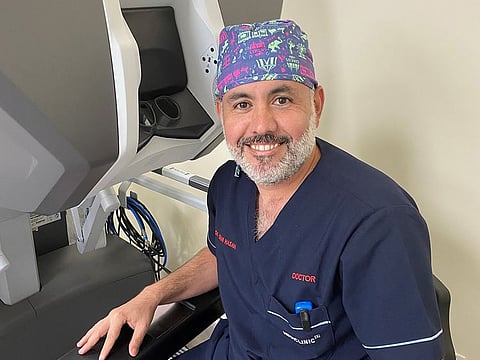Mediclinic City Hospital performs UAE’s first paediatric robotic-assisted pyeloplasty
Surgery using the Da Vinci robotic system helps restore normal renal function in two kids

Ten-year-old Hewas was presented to another hospital with severe pain in the pelvic region after drinking too much liquid. He was discovered to be suffering from hydronephrosis, the swelling of a kidney due to a back-up of urine, which occurs when urine cannot drain out because there is a blockage. The treatment suggested was an open surgery to correct the blockage. Unhappy to go ahead with the open technique, the father investigated other options and the parents were introduced to Dr Ghassan Nakib, Consultant Paediatric Surgeon at Mediclinic City Hospital, to explore and investigate further.
Robotic-assisted pyeloplasty is the most common robotic procedure performed in paediatric urology. Pyeloplasty is a reconstructive surgery of narrowing or scarring where the ureter (the tube that drains urine from the kidney to the bladder) is attached to the kidney at the renal pelvis (the narrow part of the kidney). This abnormality is called a ureteropelvic junction (UPJ) obstruction, which results in poor and sluggish drainage of urine from the kidney. UPJ obstruction can potentially cause abdominal and flank pain, stones, infection and deterioration of kidney function.
Advances in robotic technology, instrumentation, patient care and surgical expertise have allowed the correction of UPJ obstruction in most patients using this minimally invasive technique.
“UPJ obstruction occurs for various reasons but regardless of the cause, obstruction leads to hydronephrosis and can place the kidney at increased risk for reduced function,” explains Dr Ghassan. “It is the most common congenital birth defect abnormality and can present in children of all age groups.”
The same diagnosis was made for Yanis, a four-year-old boy, who presented with abdominal pain and hydronephrosis. The decision for a robotic approach was taken by the team after initial insertion of a stent (long hollow plastic tube) to improve/preserve the kidney function.
Ensuring optimal performance
After discussions with the team of surgeons, both the patients were operated on using the robotic surgery system. Dr Mudhar N Hasan, Consultant Urologist and Robotic Surgeon at Mediclinic City Hospital who performed the operations, says that robotic surgery, when compared to classical laparoscopic surgery, offers several benefits. Tremor cancellation, three-dimensional vision and vast range of motion allow the surgeon to optimally perform in confined working spaces such as those found during paediatric surgery while executing precise and delicate movements with ease. For these particular surgeries, the junction that caused the blockage was cut, reconstructed and a stent inserted until healing occurs.
The surgeries went smoothly, and the recovery of the patients and the hospital stay was shorter than expected compared with other modalities.
“The surgeon sits at a console away from the operating field and remotely controls three to four robotic arms located at the bedside,” Dr Hasan explains how the Da Vinci robotic system works. “The robotic arms attach to ports inserted into the patient, which allow instruments to be placed through the ports and into the peritoneal cavity for surgery. The robotic technology allows for three-dimensional visualisation, motion scaling, tremor filtering, an ergonomic seated position, and wristed instrument motion allowing freedom similar to open surgical instruments. Consequently, the system is capable of generating very delicate movements, ideal for urological surgery within the smaller paediatric patient.”
Better experience
“Yanis is the youngest child in the UAE to be operated on using robotic surgery,” says his parents. “The surgery was minimally invasive and went smoothly with no complications. He had a short stay in the hospital and is now recovering and enjoying his time with the family. We are deeply grateful to Dr Ghassan Nakib and his team who showed professionalism, ownership, dedication and empathy during this experience.”
Dr Roger Gerjy, Consultant General Surgeon and Director of Robotic Surgery in Mediclinic City Hospital further adds, “In the paediatric population, satisfaction is not merely based on patient satisfaction and outcomes but also related to parental satisfaction. In regard to specific variables such as postoperative pain, speed to normal activity, speed of return to normal sports, surgery incision scar, impact of surgery on parental life, burden of post-op visits/studies, and overall satisfaction, parents find a significant difference between the outcomes of robotic assisted surgery when compared to open surgery.”
This content comes from Reach by Gulf News, which is the branded content team of GN Media.